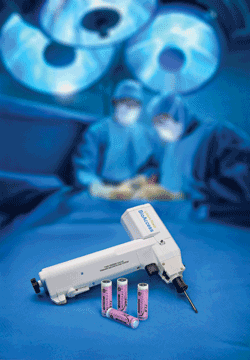New high-energy lithium batteries enable cordless bone drills to be smaller, lighter, and more powerful
BY SOL JACOBS
Tadiran Batteries, Port Washington, NY
http://www.tadiranbat.com
Like virtually all users of portable handheld devices, orthopedic surgeons prefer miniaturized equipment that is smaller, lighter, ergonomically designed, and able to work reliably in emergencies. This was foremost on the minds of design engineers at BioAccess when they began considering power management for a new generation of cordless, single-use surgical bone drills.
The original version of their portable small bone drill was powered by alkaline battery packs that performed well and offered excellent reliability. However, the company’s continuous improvement philosophy called for ongoing refinements to reduce overall weight and extend the device’s power ceiling.

A cordless bone drill powered by high-power lithium batteries provides the needed power yet reduces the weight 36% compared to alkaline batteries.
Downsizing the device could not have any performance tradeoffs, so choosing the right power management system was critically important. After reviewing all available battery chemistries, BioAccess selected a battery pack of six AA-size high-power lithium batteries (Tadiran TLM-1550-HP), which delivered 4.1-V open-circuit voltage, along with 80% greater energy density and higher capacity than equivalent alkaline batteries.
Capable of handling high-current pulses of up to 15 A, with 5-A max continuous load, this battery pack enabled the drill to deliver faster drilling speeds and more stall torque. This performance has been validated by operating-room surgeons who appreciate the drill’s increased power and better ergonomic comfort in surgery, resulting in less fatigue and more efficient drilling cycles.
The added capacity of the high-power lithium battery packs also enables more active drill time (30 to 40 s at a time, with 20 to 30 cycles) as well as more instantaneous power, as surgeons do not want power delays when using medical device.
Autoclave use
While BioAccess’ small-bone drill was specifically designed for single use at room temperature, other medical devices require a battery that can withstand the 125C temperatures commonly associated with autoclave and chemical sterilization cycles. Maximum service life can also be an important design requirement, especially for medical devices that go unused for extended periods of time, but must work reliably in life threatening situations, such as with automatic external defibrillators (AEDs).
According to Bob Chapolini, M.D., President of BioAcess, “with Tadiran TLM-1550HP cells, we get much more power in the same size package of our standard alkaline pack, and we trimmed 2.3 ounces of weight from the previous model. This weight savings is noticeable by the user since it is now significantly lighter than the earlier models. If we had used AA alkaline packs, the drill would have been three times heavier and twice the volume. That would have turned a compact, lightweight design into a heavy, bulky instrument. That is not what the surgeon wants.”
A former surgeon, Chapolini speaks from experience when he demonstrates the newer drill model in physician offices, medical conferences, and symposiums. “Any time we go to a symposium or conference, we’ve usually kept our demo units in storage for weeks or months at a time without testing system reliability,” he says. “Fortunately, every time that we have pulled a bone drill out of the box it has operated powerfully and reliably, which provides greater reassurance to the prospective customer. What’s more, the power provided for these small bone procedures is such that it may give us an opportunity to sell the drills into other classes of surgery that involve larger or heavier power tool classifications, which opens additional doors of opportunity for our product,” Chapolini adds.
Unique attributes such as extraordinarily high capacity and energy density, extremely long life and extended temperature range make these high-power lithium battery cells ideally suited for a variety of medical applications, including cauterizers, CPR resuscitation equipment, and other handheld power devices used in hospitals, clinics or field responders.
From a broader perspective, the positive results achieved by BioAccess demonstrates the need for OEM design engineers to stay abreast of the latest innovations in battery technology to achieve optimum power management solutions. ■
Advertisement
Learn more about Tadiran





